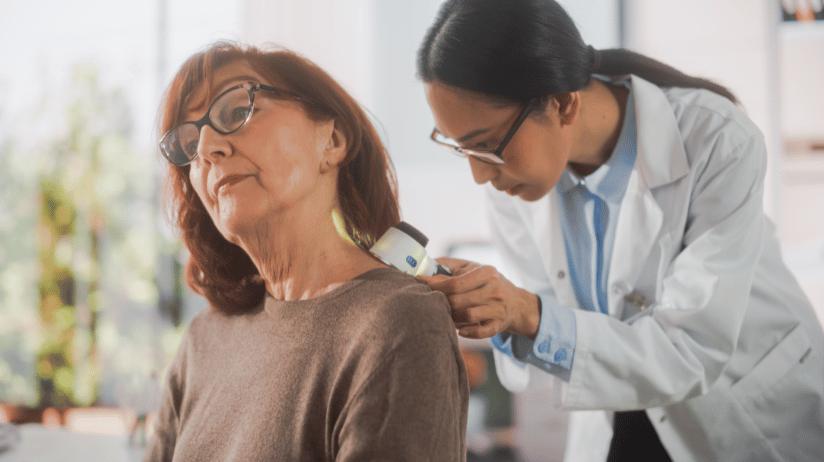
Skin cancer is one of the most common types of cancer worldwide.It affects millions of people annually, regardless of age, gender, or ethnicity.Despite its prevalence, there are still many misconceptions about skin cancer, its causes, prevention, and treatment.
Learn more about skin cancer to help you take proactive steps to protect your skin.Types of Skin CancerSkin cancer occurs when there is an uncontrolled growth of abnormal cells in the skin.Unlike normal cells, cancerous cells grow rapidly and can spread to other parts of the body if not treated promptly.There are 3 main types of skin cancer.Basal Cell Carcinoma (BCC)This is the most common type of skin cancer, accounting for about 80% of cases.
It originates in the basal cells, which are in the lower part of the epidermis (the outermost layer of skin).BCC usually appears as a pearly or waxy bump, often on sun-exposed areas such as the face and neck.While it rarely spreads to other parts of the body, it can cause significant local damage if left untreated.Squamous Cell Carcinoma (SCC)This is the second most common form of skin cancer.
It starts in squamous cells, which are flat cells found in the upper part of the epidermis.SCC typically appears as a firm red nodule or a flat lesion with a scaly, crusted surface.Like BCC, it usually occurs in sun-exposed areas but can also develop in other parts of the body.SCC can spread if not treated, making early detection crucial.MelanomaAlthough less common, melanoma is the most dangerous form of skin cancer.
It develops in the cells responsible for producing melanin, which is the pigment that gives skin its color.Melanoma can appear anywhere on the body as a new mole or a change in an existing mole.It often looks like a dark, irregularly shaped spot with multiple colors.Melanoma has a higher tendency to spread to other parts of the body and become life-threatening, making early detection and treatment vital.Skin Cancer StagesSkin cancer, like other cancers, can grow and spread.
Skin cancer stages help identify the extent of the cancer in the body.Here's a brief overview of the stages of each type of skin cancer.Stages of BCC & SCCStaging is less commonly used for basal cell skin cancers because it rarely spreads.However, it can be important for advanced cases.
Medical professionals stage squamous cell skin cancer more frequently because it tends to spread.Stage 0: Cancer cells are only in the outer layer of the skin and have not reached deeper tissue.Stage 1: The tumor is 2 cm or smaller and has not spread.Stage 2: The tumor is larger than 2 cm but has not spread.Stage 3: The cancer has spread to nearby tissues like muscle, bone, or cartilage.Or it has spread to a nearby lymph node.But it has not spread to distant parts of the body.Stage 4: The cancer has spread to distant parts of the body, such as other organs or distant lymph nodes.Stages of MelanomaMelanoma staging is more complex.
It involves a combination of tumor thickness, ulceration, and spread to lymph nodes or other organs.Stage 0: Cancer cells are only in the outer layer of the skin and have not reached deeper tissue.Stage 1: The tumor is up to 2 mm thick.It may or may not be ulcerated.It has not spread to lymph nodes or other parts of the body.Stage 2: The tumor is thicker than 2 mm and may be ulcerated, but has not spread to lymph nodes or distant sites.Stage 3: The cancer has spread to nearby lymph nodes or to nearby skin or lymphatic channels, but not to distant organs.Stage 4: The cancer has spread to distant parts of the body, such as other organs or distant lymph nodes.Causes & Risk FactorsThe primary cause of skin cancer is exposure to ultraviolet (UV) radiation from the sun or tanning beds.
UV radiation damages the DNA in skin cells, leading to mutations that can result in cancer.Several factors can increase the risk of developing skin cancer:Fair Skin: People with darker skin have more melanin, which provides some protection against UV radiation.Individuals with fair skin don't have as much melanin as a natural barrier against UV rays.History of Sunburns: Repeated sunburns, especially during childhood, significantly increase the risk of skin cancer.Excessive Sun Exposure: Spending time in the sun without adequate protection raises the risk of skin cancer.Tanning Beds: Using indoor tanning devices exposes the skin to intense UV radiation.Family History: A family history of skin cancer increases the likelihood of developing it.Immune Suppression: People with weakened immune systems, such as organ transplant recipients, are at higher risk.Age: The risk of skin cancer increases with age, although it can occur in younger people as well.Symptoms & DetectionEarly detection of skin cancer can significantly improve treatment outcomes.
Here are some common signs to watch for:New moles, bumps, or patches on the skinChanges in size, shape, color, or texture of existing molesA sore that doesnt heal or keeps coming backUnusual itching, tenderness, or pain in a mole or spotIdentifying MelanomaMelanoma has some additional warning signs to be aware of.The ABCDE rule is a useful tool for identifying potential melanomas:Asymmetry: One half of the mole doesnt match the other.Border: The edges are irregular, ragged, or blurred.Color: The color is not uniform and may include shades of brown, black, red, white, or blue.Diameter: The spot is larger than 6mm (about the size of a pencil eraser).Evolving: Any change in size, shape, color, or elevation, or any new symptom, such as bleeding, itching, or crusting.Skin Cancer PreventionPreventing skin cancer involves protecting your skin from harmful UV radiation.Here are some effective strategies to reduce your risk:Use Sunscreen: Apply a broad-spectrum sunscreen with an SPF of at least 30 every day, even on cloudy days.
Reapply every 2 hours and after swimming or sweating.Wear Protective Clothing: Long-sleeved shirts, wide-brimmed hats, and sunglasses can provide additional protection.Seek Shade: Avoid the sun during peak hours (10 a.m.to 4 p.m.) when UV rays are strongest.Avoid Tanning Beds: Refrain from using indoor tanning devices.Perform Regular Skin Checks: Examine your skin monthly for new or changing moles or spots.Visit a dermatologist annually for a professional skin exam.Treatment OptionsTreatment for skin cancer depends on the type, size, location, and stage of the cancer.
Common treatment options include:Surgery: Removing the cancerous tissue is the most common treatment.This can include simple excision, freezing, or Mohs surgery (a precise technique that removes cancer layer by layer).Radiation Therapy: Doctors use high-energy beams to destroy cancer cells that cannot be removed surgically.Chemotherapy: Topical or systemic chemotherapy may be used to kill cancer cells.Targeted Therapy: Drugs target specific molecules involved in cancer growth and spread.Immunotherapy: Boosts the bodys immune system to fight the cancer.Understanding skin cancer is the first step toward prevention and early detection.By recognizing risk factors and symptoms, you can take proactive steps to reduce your risk of developing skin cancer.
Disclaimer: This story is auto-aggregated by a computer program and has not been created or edited by Senior Savings Deals.
Publisher: Caring Senior Service ( Read More )
Publisher: Caring Senior Service ( Read More )

